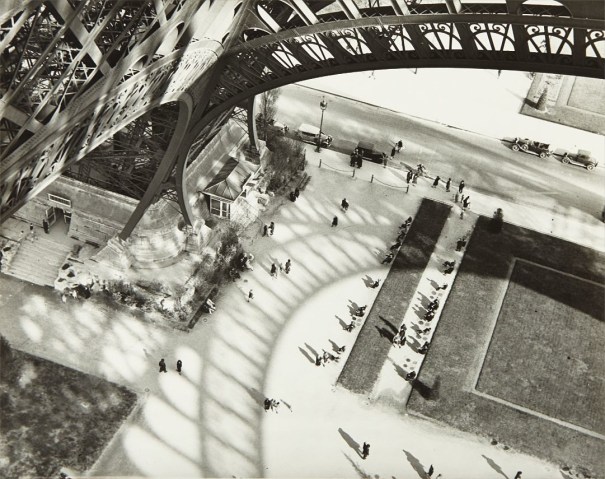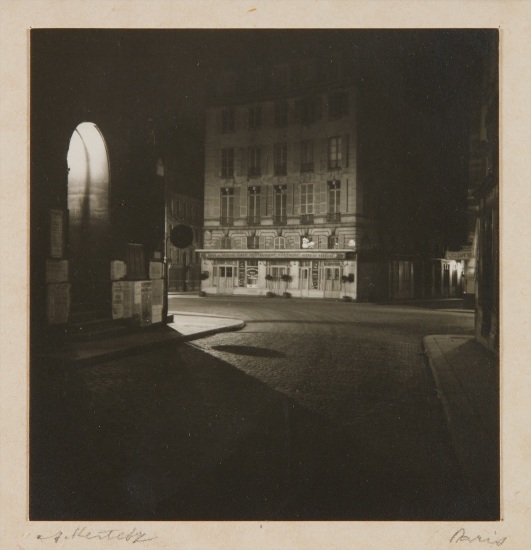THE ARC OF PHOTOGRAPHY: A PRIVATE EAST COAST COLLECTION André Kertész Distortion-Self-portrait with Carlo Rim 1930 Gelatin silver print. 9 x 5 3/4 in. (22.9 x 14.6 cm). Signed in pencil and '32 bis, rue du Cotentin' copyright credit stamp on the reverse of the paper mount.
Provenance Olivier Renaud-Clément, New York Exhibited AndréKertész, National Gallery of Art, Washington D.C., 6 February- 5 May 2005 Literature Greenough, Gurbo and Kennel, André Kertész pl. 68 Catalogue Essay As a self-taught photographer, Hungarian-born André Kertész mastered the art of photographing at a young age, claiming, “Instinctively I began to compose; I learned to perceive the moment.” Following his involvement in World War I as a soldier and photographer, Kertész resumed his interest in documenting and composing moments that, he once stated, he wanted “to eternalize.” Perhaps it was his lack of formal education, combined with his precocious curiosity that led Kertész to repudiate the Pictorialist aesthetic of the time. Accordingly, in 1923 Kertész opted to forego acceptance of a silver medal by the Hungarian Amateur Photographers’ Association for its contingency that he print his chosen image in bromoil, the favored salon photography method of the time. Aware of his incongruence with the local photographic milieu, Kertész moved to Paris in 1925, already the European hub for avant-garde Modernist thinkers, among whom were Marc Chagall Fernand Leger, Alexander Calder and Piet Mondrian The new environ provided the young Hungarian photographer with a sense of safetyto freely explore his potential role within the burgeoning field of Modernist photography. It was in Paris that he also met other Hugarian progressives, such as Brassaï, Rober Capa, Man Ray, and, as seen in lot 240, the sculptor Joseph Csáky, who had been experimenting with Cubist, and later, Deconstructivist sculpture since his move to the French capital. Kertész’s portrait of Csáky, therefore, is not a mere documentary testament to an encounter between the two countrymen, but more so, a capturing of an artistic handshake between two forward thinkers who had uprooted themselves to pursue their strong desire to challenge the norm. That same year, 1926, Kertész photographed the home of Piet Mondrian in what became one of his most celebrated images, Chez Mondrian, (lot 70)which strongly influenced Self-portrait with Still life of Vase and Book, Paris, circa 1926 (lot 237). Like the metonymic image of Mondrian’s home, Kertész’s self-portrait is comprised of a series of intersection plains and lines presenting an image that is redolent of Mondrian’s carefully composed minimalist grids. In both compositions, the image appears to be almost evenly divided by a strong vertical line, a geometric rail, a table at the foreground, and a floral arrangement atop. That Kertész inserted himself into the scene could be inferred as his alignment, on literal and figurative levels, with the renowned Constructivist painter. Kertész spent an additional decade in Paris before moving to New York in 1936. During that period he continuously explored the city with his characteristic exuberance and freedom, suffusing his images with a strong narrative and an unleashed creativity, which won him the silver medal at the Exposition Coloniale in Paris, 1931. As part of his ongoing desire to present seemingly familiar scenes in unconventional ways, Kertész began to experiment with distortions. In what could be seen as a precursor to his 1933 Distortions spread in Vu magazine under Lucien Vogel’s commission, Distortion self-portrait with Carlo Rim, 1930, (lot 239) manifests Kertész proclivity to abstract the human form in formerly unseen ways. As a double-portrait Kertész’s focus laid in capturing the essence of the era and the desire to break boundaries by the group of visionaries residing in Paris. It is also in Alone, 1931, (lot 238) that Kertész conveys his joie-de-vivre. The bird’s-eye vantage point, together with the expansive range, the lack of horizon, the absence of any additional figures, and the indefinitely stretching field allude to the sense of freedom with which the depicted man is imbued. The image could very well stand as a projected self-portrait for Kertész, who, like t
THE ARC OF PHOTOGRAPHY: A PRIVATE EAST COAST COLLECTION André Kertész Distortion-Self-portrait with Carlo Rim 1930 Gelatin silver print. 9 x 5 3/4 in. (22.9 x 14.6 cm). Signed in pencil and '32 bis, rue du Cotentin' copyright credit stamp on the reverse of the paper mount.
Provenance Olivier Renaud-Clément, New York Exhibited AndréKertész, National Gallery of Art, Washington D.C., 6 February- 5 May 2005 Literature Greenough, Gurbo and Kennel, André Kertész pl. 68 Catalogue Essay As a self-taught photographer, Hungarian-born André Kertész mastered the art of photographing at a young age, claiming, “Instinctively I began to compose; I learned to perceive the moment.” Following his involvement in World War I as a soldier and photographer, Kertész resumed his interest in documenting and composing moments that, he once stated, he wanted “to eternalize.” Perhaps it was his lack of formal education, combined with his precocious curiosity that led Kertész to repudiate the Pictorialist aesthetic of the time. Accordingly, in 1923 Kertész opted to forego acceptance of a silver medal by the Hungarian Amateur Photographers’ Association for its contingency that he print his chosen image in bromoil, the favored salon photography method of the time. Aware of his incongruence with the local photographic milieu, Kertész moved to Paris in 1925, already the European hub for avant-garde Modernist thinkers, among whom were Marc Chagall Fernand Leger, Alexander Calder and Piet Mondrian The new environ provided the young Hungarian photographer with a sense of safetyto freely explore his potential role within the burgeoning field of Modernist photography. It was in Paris that he also met other Hugarian progressives, such as Brassaï, Rober Capa, Man Ray, and, as seen in lot 240, the sculptor Joseph Csáky, who had been experimenting with Cubist, and later, Deconstructivist sculpture since his move to the French capital. Kertész’s portrait of Csáky, therefore, is not a mere documentary testament to an encounter between the two countrymen, but more so, a capturing of an artistic handshake between two forward thinkers who had uprooted themselves to pursue their strong desire to challenge the norm. That same year, 1926, Kertész photographed the home of Piet Mondrian in what became one of his most celebrated images, Chez Mondrian, (lot 70)which strongly influenced Self-portrait with Still life of Vase and Book, Paris, circa 1926 (lot 237). Like the metonymic image of Mondrian’s home, Kertész’s self-portrait is comprised of a series of intersection plains and lines presenting an image that is redolent of Mondrian’s carefully composed minimalist grids. In both compositions, the image appears to be almost evenly divided by a strong vertical line, a geometric rail, a table at the foreground, and a floral arrangement atop. That Kertész inserted himself into the scene could be inferred as his alignment, on literal and figurative levels, with the renowned Constructivist painter. Kertész spent an additional decade in Paris before moving to New York in 1936. During that period he continuously explored the city with his characteristic exuberance and freedom, suffusing his images with a strong narrative and an unleashed creativity, which won him the silver medal at the Exposition Coloniale in Paris, 1931. As part of his ongoing desire to present seemingly familiar scenes in unconventional ways, Kertész began to experiment with distortions. In what could be seen as a precursor to his 1933 Distortions spread in Vu magazine under Lucien Vogel’s commission, Distortion self-portrait with Carlo Rim, 1930, (lot 239) manifests Kertész proclivity to abstract the human form in formerly unseen ways. As a double-portrait Kertész’s focus laid in capturing the essence of the era and the desire to break boundaries by the group of visionaries residing in Paris. It is also in Alone, 1931, (lot 238) that Kertész conveys his joie-de-vivre. The bird’s-eye vantage point, together with the expansive range, the lack of horizon, the absence of any additional figures, and the indefinitely stretching field allude to the sense of freedom with which the depicted man is imbued. The image could very well stand as a projected self-portrait for Kertész, who, like t




.jpg)

Testen Sie LotSearch und seine Premium-Features 7 Tage - ohne Kosten!
Lassen Sie sich automatisch über neue Objekte in kommenden Auktionen benachrichtigen.
Suchauftrag anlegen